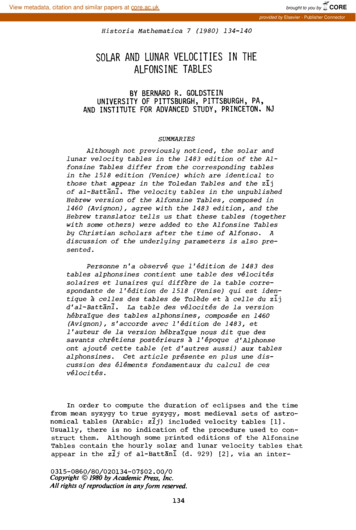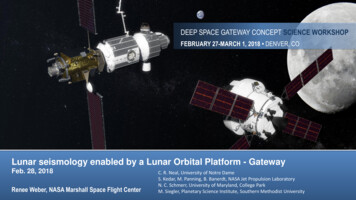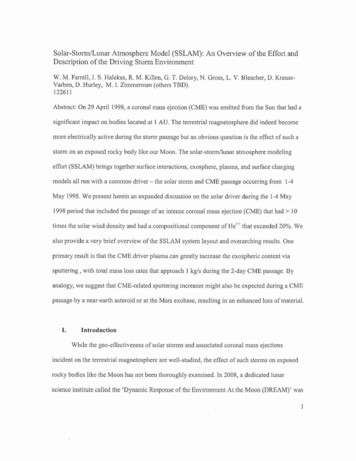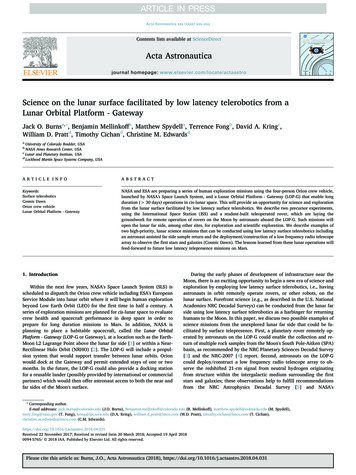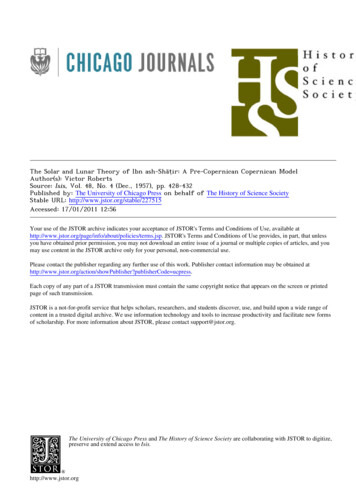
Transcription
The Solar and Lunar Theory of Ibn ash-Shāṭir: A Pre-Copernican Copernican ModelAuthor(s): Victor RobertsSource: Isis, Vol. 48, No. 4 (Dec., 1957), pp. 428-432Published by: The University of Chicago Press on behalf of The History of Science SocietyStable URL: http://www.jstor.org/stable/227515 .Accessed: 17/01/2011 12:56Your use of the JSTOR archive indicates your acceptance of JSTOR's Terms and Conditions of Use, available at ms.jsp. JSTOR's Terms and Conditions of Use provides, in part, that unlessyou have obtained prior permission, you may not download an entire issue of a journal or multiple copies of articles, and youmay use content in the JSTOR archive only for your personal, non-commercial use.Please contact the publisher regarding any further use of this work. Publisher contact information may be obtained at erCode ucpress. .Each copy of any part of a JSTOR transmission must contain the same copyright notice that appears on the screen or printedpage of such transmission.JSTOR is a not-for-profit service that helps scholars, researchers, and students discover, use, and build upon a wide range ofcontent in a trusted digital archive. We use information technology and tools to increase productivity and facilitate new formsof scholarship. For more information about JSTOR, please contact support@jstor.org.The University of Chicago Press and The History of Science Society are collaborating with JSTOR to digitize,preserve and extend access to Isis.http://www.jstor.org
an CopernicanModelBy Victor Roberts *I.Introduction.THE purposeof this note is to presentthe solarandlunartheorydevelopedA.D.) 1 inby the Damascene astronomer, Ibn ash-Shatir (I304-I375/6his KitdbNihdyatas-Suilfi TashThal-UEul (A Text of Final Inquiryin Amendig the Elements). Sincehe dispensescompletelywith the Ptolemaiceccentricdeferentand introducesa second epicycle, both his solar and lunar modelsare non-Ptolemaic.Whatis of most interest,however,is that his lunartheory,except for trivial differencesin parameters,is identicalwith that of CoperniCUS(I473-I543).Ptolemyassumeda circularpath for the sun, whereasthe orbit of Ibn ashShatir'ssun deviatesslightly from circularmotion. The major fault of thePtolemaiclunarmodelis in its exaggerationof the variationin lunardistance.The majorCopernicancontributionto the lunartheorylies in the eliminationof this Ptolemaicfault.Five copiesof Ibn ash-Shatir'swork are knownto exist, four of which areat the BodleianLibrary. They are MSS Marsh I39, Marsh 290, Marsh 50I,and Hunt 547. The fifth copy is at Leiden, Arabic MS iiI6.3In the preparationof this papera microfilmof the first of the above-mentionedcopieswas used, madeavailablethroughthe courtesyof the KeeperofOrientalBooks at the Bodleian. This manuscriptof sixty-four folios wascopied in 768 A.H. (1366 A.D.), i.e., within the lifetime of the author. In theintroductionIbn ash-Shatirclaimsthat in his treatisehe is presentinga planetary theory of finest achievement,and that he has traced and explainedallastronomicaluncertaintiesin his Ta'liqal-Arfdd (Commentson Observations). Unfortunately,this workis apparentlynon-extant.'All ibn IbrdhimAccordingto oursourcethe inventor'snameis Abui'l-Hasanalibn Mahmalainal-Humamibn Muhammadibn ersionsAbui'l-HasanAnsari. Otheral-Mut'imal-Ansari,4and 'Ala'ud-Din 'Ali bin Ibrihim Muhammad."In all* The AmericanUniversityof Beirut.'This was pointed out by Professor 0. Neu1Suter, H., Die Mathematiker und Astrono- gebauer.'Brockelmann, C., Geschichte der arabischenmen der Araber und ihre Werke, Abhandlungenzur Geschichte der Mathematik .I900), X. Heft, p. I68.(Leipzig,428Litteratur (2d ed., Leiden,'Suter, op. cit., p. i68.'Brockelmann, loc. cit.I943),voL. 2, p. I56-
THE SOLAR AND LUNAR THEORY OF IBN ASH-SHATIR429versions he is known by the name of Ibn ash-Shatir. Besides being an astronomer, he held the post of muwaqqit- one who determines the time of prayer- at the Umayyad Mosque in Damascus.2.The Solar Theory.The mean sun is represented by the center a (Figure I) of an epicycle movinging from west to east above the horizon with a daily mean motion of o; 59,8,9,5I,around the center of the universe E on a deferent of radius i,O; 0.46,57,32,306ApPleLongitudnot to scaleFIG. I.The radius of this epicycle, in length 4;37 units, rotates with respect to thedeferent radius, at the same speed but in the opposite sense, carrying thecenter b of a second epicycle of radius 2;30. This latter epicycle, with thetrue sun of radius o; IO on it, rotates with respect to the first epicycle radius' The value is expressedin the sexagesimal stands forsystem. For instance,in our notation I,2 ;32,59,I 601 2 60? 32*601 59660-2.
VICTOR ROBERTS430at double the daily mean motion and in the same direction. The enclosingheaven (al-falak ash-shdmil), has an inner radius equal to the sum of thethree given radii, or I,7; I 7. Its width is o; 43, apparently in order to roundoff its outer radius to an integer ( I,7; I 7 0; 43 i,8; o). The enclosingheaven moves from west to east at the rate of 0; 0,0,9,5I,46,5I0 per day. Thisis the motion of the solar apogee, and comes to one degree in sixty Egyptianyears of 365 days each. Figure i shows the initial and subsequent positionsof the true sun. With the given values of the parameters the solar distancevaries between 52;53 and I,7;7. Accordingly, the apparent solar diametervarying between extreme values ofhas a mean value of 0;32,320,and o;36,550.0;29,50The maximum solar equation e given by Ibn ash-Shatir is 2;2,60, and occurs at a mean longitude X of 970 or 2630, measured from apogee. It disappears at the apogee and perigee. These values have been verified by independent computation by the present author. The following method, expressedin modern symbolism, is given in the manuscript for computing e and the solardistance, p.7; 7 cOsX A, say,(The manuscripthas sin A, an obvious error.)i,o;o A B, say(The manuscript says add A if 970 7' X 2620 53', otherwise, subtractA. Such special rules to take care of negative functional values are typicalof mathematical exposition prior to the use of signed numbers. The limits ofA represent the mean longitudes which yield the mean solar distance.)2; 7 sin A c, say,thereforepandsine V/B2 c2,cpWith simple geometry this method can easily be verified by noting that 7; 7and 2; 7 are respectively the sum and differenceof the radii of the epicycles.The only observationmentioned in this connection is one made in Damascuson Tuesday, the first day of the year 70I of Yazdigerd, or 24 Rabl' al-AwwalOn the mid-day of this date, according to the732 A.H. (25 December, I33I).inventor, the mean sun and its apogee showed longitudes of ,;o?0 and i ,I9; I2 0respectively.Ibn ash-Shatir gives no motivation for his adoption of two epicycles, and itis difficultto see how his model constitutes an improvementover the Ptolemaicone.3. The Lunar Theory.The orbit of the moon is inclined at an angle of 50 to the parecliptic 7 (ofper day.radius i,9;o), and moves from east to west at the rate of 0;3,IO,38,270Ihe parecliptic (al-falak al-mumaththal) isdefinedas a circlein the plane of the eclipticwiththe earth as its center.
THE SOLAR AND LUNAR THEORY OF IBN ASH-SHATIR431The deferent, of radius i,o; o, moves from west to east around the center of theuniverse(R in Figure2) at the dailymeanlatitudinalrate of I3;I3,45,39,400.Therefore, the mean value of the moon is the sidereal motion, or I3; I0,35,I,I3?,which is the differencebetween the two values given above. The first epicycleradius ab, in length 6; 35, rotates with respect to Ra at a daily anomalistic ratea of I3;3,53,46,I8?,and in a direction opposite to the mean motion. To explainthe "second inequality" of the moon, Ibn ash-Shatir places the true moon on asecond epicycle bc of radius I; 2 5 whose daily motion from west to east is equal(double the difference between theto double the elongation e or 24; 22,53,230and the mean moon). It is of interest to compare the radiimean sun o; 59,8,20?,of the epicycles with the Copernicanvalues, which are 6;34,55,I2 and I;25,I9,I2 8 respectively. Figure 2 illustrates the motion of the moon, starting from amean conjunction in which R, a, and b are collinear.FIG. 2.As a consequenceof the resultant motion, the moon will always be in perigeep of the second epicycle at mean syzygies, and in its apogee d at quadratures.Hence, the apparent epicycle of radius 5; I0 (difference of the epicyclic radii)at the syzygies accounts for the equation of the center, and the gradual increasein its apparent radius (maximum 8;o) as it approaches the quadratures accounts for the evection. The maximumvalues of the first and second inequalitiesare 4; 56 and 2 ;44 respectively. Thus Ibn ash-Shatir has retained the ancientsum of the two inequalities, which is obtained at the quadratureswhen the linefrom the earth R to the true moon is tangent to the apparent epicycle.It follows from the given values of the parameters that the lunar distanceIDe revolutionibus,IV, 8. See also Dreyer,J. L. E., History of the PlanetarySystems (Cambridge,I906; republishedin I953 underthe title,A History of Astronomyfrom Thalesto Kepler),p. 336.
VICTOR ROBERTS432varies between 54; 50 and I, ; Io at the syzygies, and between 52 ;o and i,8;oat the quadratures. Accordingly, the apparent lunar diameter, with a meanvalue of o;32,54,330, varies between extremes of 0;29,2,15 and o;37,58,200.(The last two values are computed from the first, the only one given in the text.)The manuscriptgives the following method, expressed in modern symbolism,for computing e, the lunar equation.I;25A, say,5sin2E I;25cossay, C,say.26 B,6;35 B(The manuscript says, subtract B if go9otherwise add.)'26'o0or 3600'26 2700,V/C2 A2 r, the radius of the apparent epicycle. A ArnsiThereforesiny5; Io sin (a )5;Iocos(a )I,o;o E3600 D, say, E,say, F, say. (Add E if goo(a y)o? or2700, otherwise,subtractE.) (a. V)\/D2 F2 p.where e is the first inequality. When 5; IO is replacedpby 8; o, e will represent the sum of the two inequalities.Therefore sin e -,4. Concluding Remarks.The same manuscriptgives full parametersand descriptions of the models ofthe other planets. These await further study. Suffice it to say at the presentthat these, like the solar model, are quite different from those of Copernicus.The question which immediately arises is that of possible influence of theearlier astronomer on the later. There seems to be no way at present of resolving the problem either in one way or the other.Ibn ash-Shatir'swork was fairly well-known in the Near East, as numerouscopies and recensions of his astronomical handbook (Az-Zs- al-Jadid) andother works testify.9 There is no evidence for any of his books having beentranslated into Latin,10 and it is possible that the two individuals hit uponthe same solution independently. On the other hand, Copernicus utilized thework of other Islamic scientists, notably that of Thabit bin Qurra. Alldhu a'lim(God knows better).9 Dr. D. J. Price suggests that Ibn ash-Shatirmay have been the maker of two astrolabes preserved in Paris collections, Nos. 6 and 142 (in'1 For instance, Ibn ash-Shatir is not mentioned by F. J. Carmody in his Arabic Astronomical and Astrological Sciences in Latin Trans-Gunther,The Astrolabesof the World, Oxford, lation. A Critical Bibliography, University of1932).CaliforniaPress, I956.
The Solar and Lunar Theory of Ibn ash-Shatir A Pre-Copernican Copernican Model By Victor Roberts * I. Introduction. THE purpose of this note is to present the solar and lunar theory developed by the Damascene astronomer, Ibn ash-Shatir (I304-I375/6 A.D.) 1 in his Kitdb Nihdyat as-Suil fi TashTh al-UEul (A Text of Final Inquiry in Amend- ig the Elements).



